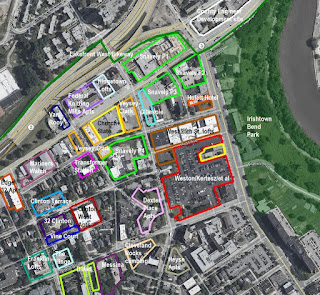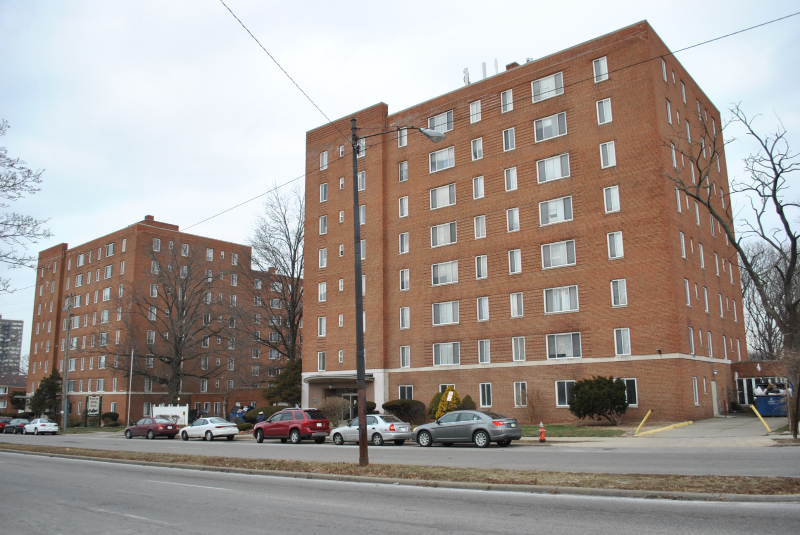Hingetown, that little enclave within a neighborhood within a city seemingly couldn’t be growing any faster than already it is. No matter where you stand in Hingetown these days, you’re either standing next to a 21st-century real estate development, across the street from one or you can see one less than a block away. Increasingly, in Hingetown, you’re surrounded by projects.
That’s a dramatic change considering that drug dealers and prostitutes once roamed this northeast corner of Cleveland’s Ohio City neighborhood. Today, they have given way to young professionals eager to share their fresh ideas, families pushing baby strollers and entrepreneurs looking to make their mark or a new start. It’s come a long way from what was a “toxic corner” as Vanity Fair told the enclave’s story four years ago.
Now, one of the neighborhood’s biggest developers,?The Snavely Group, is rapidly expanding its footprint on Detroit Avenue which is along the northern edge of Hingetown (actually, the West Shoreway seems to be the unofficial northern boundary).
By the end of this year, Snavely reportedly hopes to delve into Phase 3 of its multi-phase, mixed-use, mixed-income development, moving westward from West 25th Street. A fourth phase may not be far behind that.
“This project is a place-making project,” said Peter Snavely Jr., vice president of development for the Snavely Group in a written statement. “It’s a mixed-use, mixed-income, socially-driven project.”
Last year, Snavely completed its first phase at the northwest corner of Detroit and West 25th, called The Quarter — 194 apartments above 30,000 square feet of ground-floor commercial space. The commercial space is fully leased and the residential units are 93 percent leased, according to The Quarter’s Web site. The development replaces a huge, windswept parking lot.
Tenants for the ground-floor commercial space in The Quarter include the Music Settlement, an early education and music school, APG Office Furnishings, D.O. Summers dry cleaners, and The Grocery OHC, a local grocery offering healthy, locally sourced food. But the first phase also continues across Detroit — though only to the ground floors of two historic buildings. There, Hingetown’s reputation as a place where entrepreneurs can find a guiding hand is enhanced.
The first floor of the Forest City Savings and Trust Building was renovated into the Ohio City Galley, a restaurant incubator including a 200-seat food hall and four kitchens for new-start restaurateurs. To the west is the Seymour Building whose first floor was redeveloped with the The Beauty Shoppe, a co-working office space and Foyer cafe, according to an article by Novogradac & Company LLP, a real estate services consulting firm specializing in affordable housing development.
 |
| Soil boring equipment for geotechnical testing was on the site of Snavely’s planned third phase of its Hingetown master development during the first week of April (KJP). |
The second phase stayed in one of those historic buildings. Snavely is renovating the upper floors of the Forest City Savings and Trust Building with 38 affordable apartments. The building will be renamed Forest City Square, with work due to be completed by the end of the year. Total investment among the first two phases is $60 million.
Next is the third phase – 88 apartments in two buildings. One is an existing structure — the three-story Painters Union building at 2605 Detroit Ave. that is due to be renovated. Next to it could be a newly built, five-story building like The Quarter across Detroit albeit smaller in land area. It will be on the April agenda of the Clinton-Franklin Block Club which will meet at 7 p.m. April 25 at St. John’s Parish Hall, 2600 Church Ave.
 |
| An image from the schematic designs for phase 3, submitted by Snavely to the city for approval. A renovated painters Union building is at left and the new-construction element is at right. (Vocon) |
Deciding whether to pursue a third phase likely wasn’t a difficult one for Snavely, considering the speed and market-rate rents at which The Quarter leased out. But the third phase, due to start this fall, will feature affordable apartments for residents earning 80 percent of the average median income. Snavely was able to offer reduced-rate apartments thanks in part to Opportunity Zone funding, according to the Novogradac article.
A possible fourth phase may come in a couple of years, pending the relocation of two businesses. The first relocation would be Cleveland Vibrator Company, 2828 Clinton Ave. Its relocation, which isn’t yet finalized, would make way for the other relocation, that of The Adcom Group whose offices are currently located at 1370 W. 6th St. in downtown’s Warehouse District.
 |
| The 1.7-acre Hingetown site of the Cleveland Vibrator Company is being acquired for redevelopment, including for ground- floor offices and apartments on the upper floors (Google/KJP). |
Although still in a preliminary stage, four sources say the development concept for the fourth phase involves putting the offices for Adcom, a fast-growing marketing company, on the lower floors of a new building with apartments on the upper floors.
“I personally, along with some other partners, are in the process of buying some commercial property in Ohio City,” said Adcom CEO Joe Kubic. “We haven’t yet finalized our plans for it though. It is certainly a possibility that Adcom may relocate there at some point, but we are happy in our current location as of now.”
Few places in Greater Cleveland have had so many real estate development projects built or planned in so small of an area in recent years as Hingetown. While downtown adds housing units in big gulps, Hingetown adds them in seemingly countless nibbles. Even as this walkable neighborhood’s bites into the market are getting bigger, the appetite seems insatiable.
The spark to this development brush fire began with a main street of shops, cafes and restaurants along West 29th Street south of Detroit. It was led by investors Marika Shiori-Clark and Graham Veysey. They named it Hingetown because it’s like a hinge between the Gordon Square Arts District, the Market District, and the Warehouse District.
The goal was and is to have an inclusive, socially conscious, entrepreneur-based enclave, located in the cultural heart of Cleveland’s LGBT community. Shiori-Clark and Veysey renovated an 1854-built firehouse with a coffee shop and businesses. Other pioneering efforts were the Federal Knitting Mills Apartments conversion and renovation of a long-vacant streetcar electrical substation-turned-art gallery called the Transformer Station.
END






Parking?
What development is planned for the area in red which is the Lutheran Hospital parking
Lot.
Yes, all new developments are adding parking.
A potentially large mixed-use development, if Cleveland Clinic agrees to sell the parking lot. Developing it will require the developers, or a sponsor on their behalf, to build a multilevel parking deck for Lutheran Hospital employees and visitors. That makes this site more complicated and expensive and thus, it is very uncertain.
Great article! How many apartments will there be in the Seymour Building?
Thanks. It appears the Seymour Building will be commercial, not residential. It is proposed to have about 22 office/co-working spaces plus a cafe.